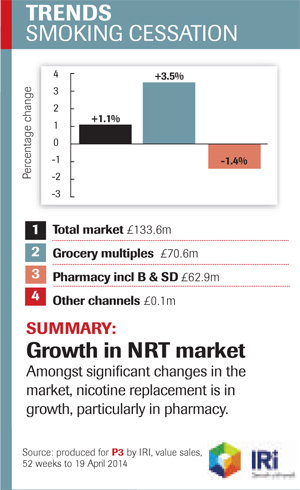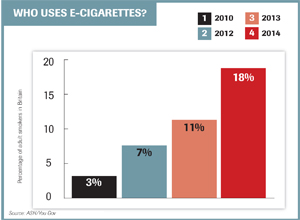Tobacco harm reduction and a changing market
In Population Health
Follow this topic
Bookmark
Record learning outcomes
The areas of nicotine replacement and smoking cessation have recently been broadened by the growth of nicotine-containing products and tobacco harm reduction. What’s the latest in this fast developing category?
An update of issues around e-cigarettes, healthcare and pharmacy’s position relating to them was discussed at a meeting of the All Party Pharmacy Group (APPG) last month. Government has accepted the advice of the Commission on Human Medicines (CHM) and concluded that nicotine-containing products (NCPs) currently on the market do not meet appropriate standards of safety, quality and efficacy. ‘Testing data confirm that nicotine levels can vary considerably from the labelled content, and the amount of nicotine per product can differ from batch to batch,’ says a Department of Health statement. But the DH appears positive about the potential place for the devices in healthcare, saying: ‘The current evidence is that electronic cigarettes have shown some promise in helping smokers quit tobacco, but the quality of existing NCPs is such that they cannot be recommended for use.’ Regulation will allow safety of use to be monitored and advertising to be controlled.

Pharmacy Voice recognises that there are differences in opinion about e-cigarettes and pharmacy, but that there are areas of agreement across the profession, including the Royal Pharmaceutical Society. For example:
- If a Nicotine Replacement Therapy (NRT) product is considered the best option for a person attempting to quit or reduce their looking then pharmacists should encourage the use of licensed products
- Greater regulation is required to standardise these devices and provide greater assurances for patients and the public. Serious risks still exist concerning the accidental ingestion of cartridges by children
- Where a pharmacy owner decides to sell e-cigarettes, pharmacists should be free to exercise their clinical and professional judgement, as they would normally do in the exercise of their professional practice.
An evidence-based review produced by Pharmacy Voice is available from www.pharmacyvoice.com/images/resources/ electronic_cigarettes_evidence.final.pdf
Â
Electronic cigarettes are devices that allow users to inhale vapourised nicotine dissolved in propylene glycol or glycerine.
There are three main types of e-cigarettes or vapourisers:
- Disposable products (non- rechargeable)
- An e-cigarette kit that is rechargeable with replaceable pre-filled cartridges
- An e-cigarette that is rechargeable and has a tank or reservoir which has to be filled with liquid nicotine.
Source:ASH, www.ash.org.uk
Emerging evidence
The health charity ASH estimates that in the past two years, use of electronic cigarettes  among adults in Britain has tripled to 2.1 million in 2014. About a third of e-cigarette users are ex-smokers and two-thirds are current smokers. Half of those who still smoke are actively trying to quit.
among adults in Britain has tripled to 2.1 million in 2014. About a third of e-cigarette users are ex-smokers and two-thirds are current smokers. Half of those who still smoke are actively trying to quit.
Users are predominately smokers or past smokers, research shows. ‘Although some have concerns that electronic cigarettes could be a gateway for young people to start smoking, current data show that regular use of electronic cigarettes among children and young people is confined almost entirely to those who currently or who have previously smoked,’ says an ASH statement.
A joint review of data from University College London, Queen Mary University of London, Kings College London and action group ASH concluded:
- E-cigarettes are much less harmful than smoking (by at least 20 times)
- The use of e-cigarettes by never smokers is, to date, extremely rare
- Use of e-cigarettes by smokers is increasing, and is currently at about 20 per cent.
Research published in the journal Addiction in May this year was a boost for the booming e-cigarette industry, with results indicating that electronic cigarettes could potentially help boost smokers’ quit rates by 60 per cent compared with other methods such as nicotine patches, gum or willpower. However, Professor Robert West, from University College London, comments that NHS stop smoking services, which were not used by anyone participating in the survey, can almost triple a smoker’s odds of successfully giving up smoking compared to over the counter products.
Cancer Research UK is currently funding research into the use of e-cigarettes, and the head of tobacco policy at the organisation, Alison Cox, recently told the Daily Mail that the  evidence for their effectiveness in helping people to quit is so far ‘limited’. Cancer Research UK is funding research to help inform policy development and individuals’ choices, she said.
evidence for their effectiveness in helping people to quit is so far ‘limited’. Cancer Research UK is funding research to help inform policy development and individuals’ choices, she said.
The future of tobacco harm reduction looks as if it could well get even more interesting, with a further report from Public Health England clarifying the organisation’s own position on e-cigarettes or cigalike’ products. This talks about the interesting possibility of further and different nicotine delivery devices in the future.
PHE is clear that the key requirement of any method is to ‘monitor and where necessary identify opportunities to intervene to ensure that uptake and use follow patterns most likely to benefit public health, and act to prevent loopholes or practices that run counter to this objective.’
With opinions divided within the pharmacy profession some pharmacies have already decided to work with manufacturers of e-cigarettes – Lloydspharmacy stocks BATs Vype and Boots is stocking Puritane, both brands with substantial clinical research already behind them, giving reassurance to customers about quality.
Fontem Ventures, a subsidiary of Imperial Tobacco, launched Puritane across the UK in exclusively with Boots, giving consumers access to the Puritane range in more than 2,000 stores across the UK. A representative from Fontem Ventures commented, ‘Boots UK is a retailer that shares our own high quality standards and a commitment to quality will remain key to Fontem Ventures commercial plans moving forward. Puritane has been rigorously tested and successfully passed through Boots’ own demanding approval process.’
Understandably, the established NRT sector is responding to changes in the wider market with new products, along with a stronger marketing message about the role that nicotine replacement plays in quitting.
Elizabeth White, senior brand manager for NiQuitin, says that meeting customers’ needs is key. ‘Innovation is key in driving the smoking cessation category. We are confident that by delivering a variety of formats, this will give our quitters the opportunity to find a method and format that works best for them and their lifestyles.’ NiQuitin Strips, launched last year acts to relieve the urge to smoke in 50 seconds.
Regulation ahead
Companies that intend to market electronic cigarettes will have to meet either medicines or Tobacco Products Directive regulations, probably from 2017 at the latest. PHE is optimistic  about being able to integrate nicotine delivery into public health policy, to complement existing comprehensive tobacco control policies.
about being able to integrate nicotine delivery into public health policy, to complement existing comprehensive tobacco control policies.
With regards to promotion of e-cigarettes and other nicotine delivery devices, the fact that they can’t be promoted as a method of smoking cessation, just as an alternative to traditional cigarettes, could potentially cause pitfalls for sales staff. This can be overcome with specific, thorough training. In the case of Puritane: ‘Fontem Ventures worked closely with Boots UK to develop a comprehensive sales and training programme for Boots pharmacists. We recognise that many smokers and ex-smokers are turning to e-cigarettes (for a whole variety of reasons) and that the category is quickly moving from niche to mainstream.’
Fontem says it has plans to launch a new electronic nicotine device later this year, but is keeping the details under wraps for now.
There’s likely to be interesting news from some of the more traditional tobacco companies in the very near future too, with British American Tobacco bringing a new device to market, via subsidiary company Nicoventures, which will be more like a metered dose inhaler than an electronic cigarette. Philip Morris has also invested in the development of a patented novel nicotine device.
Market analyst Euromonitor predicts that four per cent of the global smoking market will be smoking e-cigarettes by 2050.
Comment
 Lila Thakerar, Shaftesbury Pharmacy, Harrow ‘The Department of Health is publicising the dangers of smoking and this is making smokers more determined to give up because of the apparent risks. Some smokers are not aware of the NHS stop smoking service that pharmacists provide but they may look for advice when buying over the counter NRT products. This is an ideal opportunity for staff to register patients on to the NHS Stop Smoking Service, if this is provided in the pharmacy. The brand leaders are Nicotinell, Nicorette and NiQuitin, with products ranging from different strengths to forms of presentation.’
Lila Thakerar, Shaftesbury Pharmacy, Harrow ‘The Department of Health is publicising the dangers of smoking and this is making smokers more determined to give up because of the apparent risks. Some smokers are not aware of the NHS stop smoking service that pharmacists provide but they may look for advice when buying over the counter NRT products. This is an ideal opportunity for staff to register patients on to the NHS Stop Smoking Service, if this is provided in the pharmacy. The brand leaders are Nicotinell, Nicorette and NiQuitin, with products ranging from different strengths to forms of presentation.’
 Dilip Patel, Mirage Pharmacy, Handsworth ‘We have a range of products available for tobacco control, including patches and gum, to suit every type of customer depending on their lifestyle and how many cigarettes they are smoking a day. We do stock e-cigarettes because there is a demand for them. But we know what the GPhC and the Society is saying about it. At the end of the day, you have to give the customers what they want, not what we think they want. If a customer thinks they will cut down on their tobacco intake by smoking an e-cigarette, I see that as having a positive effect because they’re going to be smoking fewer cigarettes every day. We emphasise that if people fail to quit first time, not to worry, just keep at it, as it can take five or six goes before a customer gives up altogether.’Â
Dilip Patel, Mirage Pharmacy, Handsworth ‘We have a range of products available for tobacco control, including patches and gum, to suit every type of customer depending on their lifestyle and how many cigarettes they are smoking a day. We do stock e-cigarettes because there is a demand for them. But we know what the GPhC and the Society is saying about it. At the end of the day, you have to give the customers what they want, not what we think they want. If a customer thinks they will cut down on their tobacco intake by smoking an e-cigarette, I see that as having a positive effect because they’re going to be smoking fewer cigarettes every day. We emphasise that if people fail to quit first time, not to worry, just keep at it, as it can take five or six goes before a customer gives up altogether.’Â
 Nemesh Patel, AMG Pharmacy, Braintree ‘I firmly believe that pharmacy has an important role in providing smoking cessation services. All our staff have undergone national accreditation and are in an excellent position to deliver advice with confidence and understand each customer’s needs. In our experience, transdermal patches and nasal sprays are most successful in helping patients to quit, and we also provide free carbon monoxide level testing – a fantastic motivational tool. If you have well trained staff who are knowledgeable about the products and proactive in educating customers on the health and financial benefits of stopping smoking, your sales will definitely increase.’
Nemesh Patel, AMG Pharmacy, Braintree ‘I firmly believe that pharmacy has an important role in providing smoking cessation services. All our staff have undergone national accreditation and are in an excellent position to deliver advice with confidence and understand each customer’s needs. In our experience, transdermal patches and nasal sprays are most successful in helping patients to quit, and we also provide free carbon monoxide level testing – a fantastic motivational tool. If you have well trained staff who are knowledgeable about the products and proactive in educating customers on the health and financial benefits of stopping smoking, your sales will definitely increase.’
